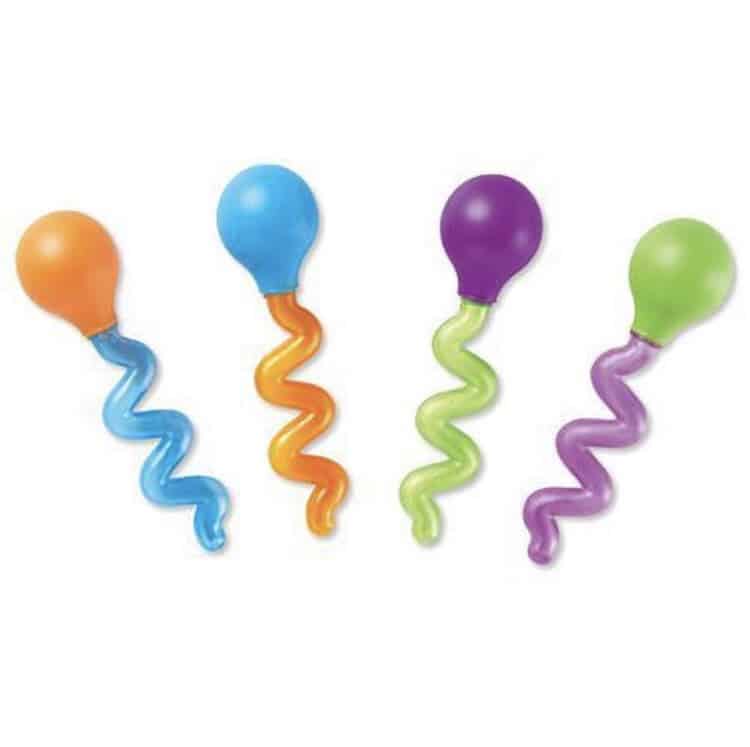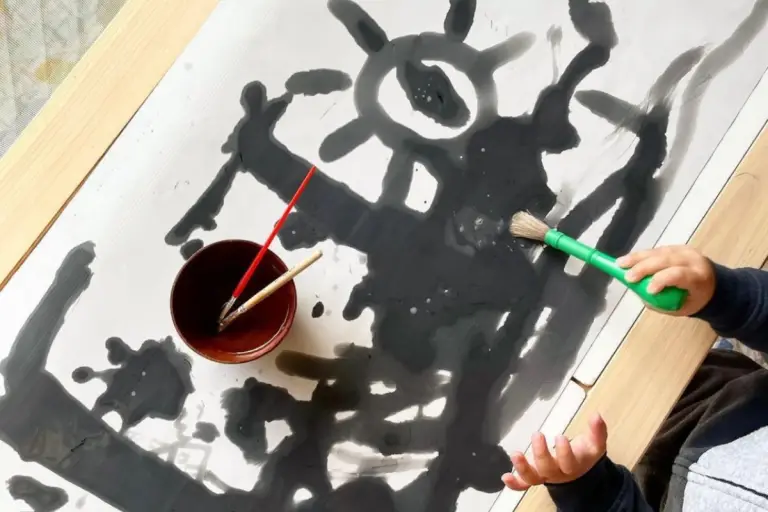Fizzy Dinosaur Eggs
Disclosure: This blog contains affiliate links which I may earn a small commission from if you purchase through them, at no extra cost to you.
Dapple with a bit of science at home with the kids with this two-part, sensory activity! These Fizzy Dinosaur Eggs are easy to create at home with your toddler and preschooler, using common pantry ingredients!

Fizzy Dinosaur Eggs
Chemical reactions are fascinating for both kids and parents alike!
This Fizzy Dinosaur Egg experiment involves the reaction between an alkaline product and an acidic product.
It is a classic combination of two household products that have been used for generations for all sorts of uses around the home.
Today, we are using this reaction to create some entertaining learning because it really is so much fun!
- What is a fizzy egg?
- How do you make fizzy dinosaur eggs?
- What happens when you mix baking soda and vinegar together?
- What are forms of matter?
- Scientific observations
- How to set up your fizzy dinosaur eggs activity
- What you need to create fizzy dinosaur eggs
- How do you make a dinosaur egg with baking soda?
- Learning through play opportunities
- What you need to hatch your fizzy dinosaur eggs
- Conversation starters
What is a Fizzy Egg?
Fizzy eggs are where science meets fun!
Hatch a dinosaur using a chemical reaction that bubbles and sizzles!
The heroes of this experiment are baking soda, or sodium bicarbonate, and vinegar. There is nothing too fancy in regards to the ingredients. By all means, these are the very same that you probably have lurking in your pantry already.
In short, the alkaline bicarbonate of soda reacts with the acidic vinegar to create carbon dioxide.
A chemical reaction occurs when the baking soda meets the vinegar, resulting in a frenzy of bubbles!
How do you make Fizzy Dinosaur Eggs?
Making your own fizzing dinosaur eggs is so easy! The ingredients are most likely already in your home. If you do need to pop down to the store, they are super affordable and can be used for so many other fun science experiments for kids.
These dinosaur eggs are so fun to hatch out. The sizzles and bubbles are typically the perfect rewards for your little one’s patience. As they navigate the pipette or syringe, coordinating the steps and tak
What happens when you mix baking soda and vinegar together?
The science behind this activity is a great way to introduce your child to chemistry. Feeding your childs natural curiousity will open up so many conversations and present so many questions – brilliant for developing cognitive thinking and language development!
This baking soda and vinegar science experiement is a great way to demonstrate forms of matter and the difference between chemical and physical changes.
What are forms of matter
Forms of matter include solid, liquid, gas, plasma, Bose- Einstein condensates and fermionic condensates.
Our experiment will allow your child to observe solid, liquid and gas forms of matter.
Solids – Baking Soda
Solids will often resist distortion. They are rigid, stable and three dimensional in shape. Solids will remain in much the same shape when not confined.
Liquids – Vinegar
Liquids will flow and be contained within the lowest part of its container. They can be difficult to compress and have a constant volume.
Gases – Carbon Dioxide
Gases have lower density and wil expand to take on the shape of their container. These are easily compressed and have no fixed volume.
While making fizzy dinosaur eggs, your child can observe the different forms of matter and how they interact with each other.
Scientific Observations
- Physical change: When water is added to the baking soda, the baking soda can be compressed to form the egg shape. While the egg is different to the previously loose powder, it remains chemically the same.
- Chemical change: Upon dropping the vinegar to the egg, there is a chemical reaction resulting in a new substance being formed. The solid baking powder reacts with the liquid acetic acid and water (vinegar), which in turn results in creating carbon dioxide gas and sodium acetate liquid.
How to set up your Fizzy Dinosaur Eggs activity
This science experiment is broken down into two sections. There is some freezing time required which I feel only helps build the excitement! While ours are setting, I often hear the creak of our freezer door opening and two sets of curious eyes peering in to see their creations resting in the cold.
Part one of creating your Fizzy Dinosaur Eggs is creating the eggs themselves.
What you need to create your Fizzy Dinosaur Eggs
- 500g Baking Soda
- 5 tablespoons water (approximately)
- Bowl
- Spoon
- Tray
- 4 Small Dinosaur Figurines
- Food colouring (optional, we used two primary colours so we could watch the colours change)

How do you make a dinosaur egg with baking soda?
- Add your baking soda to your bowl.
- Add a couple of drops of your food colouring, if you’re creating coloured eggs, then add water one spoon at a time, stirring between each one until the baking soda is malleable. It will seem crumbly in the bowl however under pressure, the mixture will come together once the correct amount of water has been added.
- Place a couple of spoons of the baking soda mixture into the palm of your hand and press it gently to form a foundation to press your dinosaur into.
- Place the dinosaur on top before adding more of the baking soda mixture to form an egg shape. Now, this step may be challenging for some younger children. It is a matter of applying enough pressure to form the egg, without using too much that the egg breaks apart.
Once formed, place your eggs onto the tray before placing them into the freezer for a couple of hours to set. We left ours overnight – really just to build on the excitement for the next day.



Part two of your Fizzy Dinosaur Egg science experiment is all about the chemical reaction and hatching of your dinosaurs!
Learning through play opportunities
Let the real fun begin! Kids love watching this part of the experiment! There are bubbles and hisses and fizzles! Learning through play is so much fun! Hatching their dinosaurs is an experience they will love and there are loads of educational and learning opportunities that can stem from doing so!
- Cause and effect
- Fine motor skills
- Sequencing events
- Crossing the midline
- Building vocabulary
- Turn taking
- Social skills
What you need to hatch your Fizzy Dinosaur Eggs
- Your eggs as made in Part 1
- Pipette or syringe ( we used one of each)
- 3 x Bowls
- White Vinegar

We made four eggs, so the girl could have two each to hatch. Each child was given a little bowl for them to place their egg into. Use the third bowl to add your vinegar.
Fast tip: only add a small amount of vinegar into the bowl at a time in case the kids drop some baking soda mixture into the bowl, reducing its effectiveness.
Using your pipette or syringe, draw up some of the vinegar then drip it over the egg!
Instantly your child will be rewarded with a display of bubbles, fizzles and hisses as the acidic vinegar reacts with the alkaline baking soda! With each squirt of vinegar, the baking soda egg will fizzle away and soften before revealing the dinosaur within!



Conversation starters
This science experiment is full of opportunities to build on your child’s vocabulary and comprehension. Remember to start with things they know and use this as a foundation to build on. Questions you could ask include
- What do you think will happen when we add the water to the baking soda
- What is the name of this dinosaur
- Why do you think the eggs fizzle
- What do you think the dinosaur would have eaten
- How do you think the baking soda mixture will feel
- Who do you think might enjoy this science experiment
- What do you think will happen when the vinegar touches the eggs
- How long do you think it will take to hatch the eggs
- When have you heard a sound like this before

This science experiment is a hit every time! The big kids seem to enjoy it just as much as the small ones too – perfect for families with toddlers and school-age children to do together! Fizzy Dinosaur Eggs really are so easy to make and are great fun. What other types of eggs could you make?
When you give this experiment a go, please feel welcome to share your experience on our Play Inspired Mum Facebook Group! We would love to see what your family creates!
Do your kids love science experiments? Why not check out this Rainbow Eruption or these pH experiments
Happy learning!










